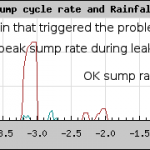The morning after the first rain after installing a new sump discharge line, I was greeted with a loud water flow kind of noise. It was a big leak, but thankfully (if amazingly!) confined within the sump, with no water escaping outside the sump. The 13′ of new 1.5″ pipe provided about 1.3 gal of pumped-almost-out water to refill the sump through this leak for every sump cycle.
Apparently, the increased pressure from the longer, higher discharge run out to the front of the house – probably made worse by the hydraulic ram effect of the extra mass of water coming back when the check valve closed – “blew apart” the connection  between the main discharge line and the backup pump. I pushed the two bits of pipe back into the flexible coupling and cranked the clamps down tight, and that seems to have fixed it. Sorry for mismatched camera angles, but you can see how much less pipe is visible outside the coupling in the bottom shot after fixing it.
between the main discharge line and the backup pump. I pushed the two bits of pipe back into the flexible coupling and cranked the clamps down tight, and that seems to have fixed it. Sorry for mismatched camera angles, but you can see how much less pipe is visible outside the coupling in the bottom shot after fixing it.
A scary side effect of pushing those pipes apart was that it also pushed the two pumps apart. The main pump was jammed against the side of the sump instead of sitting more or less in the middle. This movement could have jammed the float against the sump wall, preventing it from moving, resulting in a sump overflow (or possibly a continuously running pump). Fortunately, the Zoeller pump designers included a guard ring around the float to prevent that problem. It probably saved me from a wet basement. Thanks, Zoeller!
Of course Murphy took advantage of my early morning uncaffeinated fogginess and provided the requisite fuck up of a 1.5″ diameter plume of water being pumped up at me from a not-yet-connected pipe. While I had used the piece of coat hanger wire with a hook on the end that lives next to the sump (just for such uses) to pull up the float switch and drain the sump as much as I could before disconnecting the discharge line and lifting the pumps out, I missed the step of unplugging the sump power cable. After I’d reconnected the backup pump and tightened the clamps on the rubber coupling down well, I lowered the assembly back into the sump – thinking I was almost done. Of course the sump had refilled enough that the float switch triggered and the pump turned on while the pipe was still in my hands. I did have the presence of mind to pull the sump pump plug before it pumped any more water out on the floor. Yeah, yeah, I pulled it out by the cord instead of by the plug. Under the circumstances I think that was a justified cheat.
 The one other surprise was the difficulty in disconnecting the pump from the new discharge pipe. They were connected with the same piece of rubber sleeve that’s been connecting the series of sump pumps to the iron outlet pipe for the last 25 years. It usually slips down the pump pipe fairly easily after the clamps are loosened. But not this time. I even started wondering if the guy who did the piping (not me) had glued the joint together! (He had not.) Recalling how hard it had been to disassemble, when I put it back together I used a shiny new (and looser) coupling. (I’d laid in a stock of 1.5″ pipe fittings after a bad storm and dry well backup forced me to re-plumb the discharge pipe out a basement window. I suppose I should write that up some time.)
The one other surprise was the difficulty in disconnecting the pump from the new discharge pipe. They were connected with the same piece of rubber sleeve that’s been connecting the series of sump pumps to the iron outlet pipe for the last 25 years. It usually slips down the pump pipe fairly easily after the clamps are loosened. But not this time. I even started wondering if the guy who did the piping (not me) had glued the joint together! (He had not.) Recalling how hard it had been to disassemble, when I put it back together I used a shiny new (and looser) coupling. (I’d laid in a stock of 1.5″ pipe fittings after a bad storm and dry well backup forced me to re-plumb the discharge pipe out a basement window. I suppose I should write that up some time.)
 Update a little later: Here’s how the monitoring system caught the frequent sump pump cycling due to the leak, with the very visible drop to a more appropriate rate after the fix.
Update a little later: Here’s how the monitoring system caught the frequent sump pump cycling due to the leak, with the very visible drop to a more appropriate rate after the fix.

